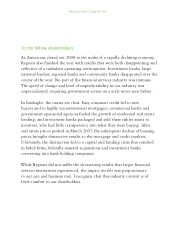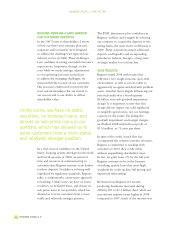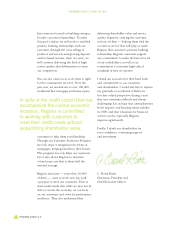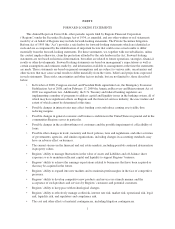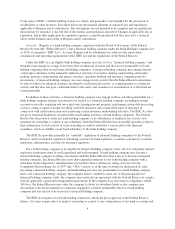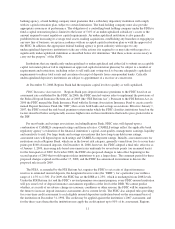Regions Bank 2008 Annual Report Download - page 11
Download and view the complete annual report
Please find page 11 of the 2008 Regions Bank annual report below. You can navigate through the pages in the report by either clicking on the pages listed below, or by using the keyword search tool below to find specific information within the annual report.PART I
FORWARD-LOOKING STATEMENTS
This Annual Report on Form 10-K, other periodic reports filed by Regions Financial Corporation
(“Regions”) under the Securities Exchange Act of 1934, as amended, and any other written or oral statements
made by or on behalf of Regions may include forward-looking statements. The Private Securities Litigation
Reform Act of 1995 (the “Act”) provides a safe harbor for forward-looking statements which are identified as
such and are accompanied by the identification of important factors that could cause actual results to differ
materially from the forward-looking statements. For these statements, we, together with our subsidiaries, unless
the context implies otherwise, claim the protection afforded by the safe harbor in the Act. Forward-looking
statements are not based on historical information, but rather are related to future operations, strategies, financial
results or other developments. Forward-looking statements are based on management’s expectations as well as
certain assumptions and estimates made by, and information available to, management at the time the statements
are made. Those statements are based on general assumptions and are subject to various risks, uncertainties and
other factors that may cause actual results to differ materially from the views, beliefs and projections expressed
in such statements. These risks, uncertainties and other factors include, but are not limited to, those described
below:
• In October of 2008, Congress enacted, and President Bush signed into law, the Emergency Economic
Stabilization Act of 2008, and on February 17, 2009 the American Recovery and Reinvestment Act of
2009 was signed into law. Additionally, the U.S. Treasury and federal banking regulators are
implementing a number of programs to address capital and liquidity issues in the banking system, all of
which may have significant effects on Regions and the financial services industry, the exact nature and
extent of which cannot be determined at this time.
• Possible changes in interest rates may affect funding costs and reduce earning asset yields, thus
reducing margins.
• Possible changes in general economic and business conditions in the United States in general and in the
communities Regions serves in particular.
• Possible changes in the creditworthiness of customers and the possible impairment of collectibility of
loans.
• Possible other changes in trade, monetary and fiscal policies, laws and regulations, and other activities
of governments, agencies, and similar organizations, including changes in accounting standards, may
have an adverse effect on business.
• The current stresses in the financial and real estate markets, including possible continued deterioration
in property values.
• Regions’ ability to manage fluctuations in the value of assets and liabilities and off-balance sheet
exposure so as to maintain sufficient capital and liquidity to support Regions’ business.
• Regions’ ability to achieve the earnings expectations related to businesses that have been acquired or
that may be acquired in the future.
• Regions’ ability to expand into new markets and to maintain profit margins in the face of competitive
pressures.
• Regions’ ability to develop competitive new products and services in a timely manner and the
acceptance of such products and services by Regions’ customers and potential customers.
• Regions’ ability to keep pace with technological changes.
• Regions’ ability to effectively manage credit risk, interest rate risk, market risk, operational risk, legal
risk, liquidity risk, and regulatory and compliance risk.
• The cost and other effects of material contingencies, including litigation contingencies.
1



